A Detailed Report on the Problems and Financial Issues of PFI Projects
VerifiedAdded on 2022/09/27
|8
|1481
|21
Report
AI Summary
This report critically examines the problems associated with the Private Finance Initiative (PFI) in Britain, focusing on financial losses and inefficiencies. It highlights the findings of the National Audit Office, emphasizing that PFI projects, including those for schools and hospitals, were significantly more expensive than government borrowings. The report details the collapse of Carillion and its impact on various sectors, including NHS, education, and prisons, and the subsequent criticism of PFI. It explores how PFI schemes often transferred risks without delivering value for money, leading to misuse of taxpayer money and excessive profits for private contractors. The report provides examples of inflated costs and suggests that future governments should renegotiate or cancel PFI projects to safeguard taxpayer money. The report is well-researched and cites various sources to support its claims.
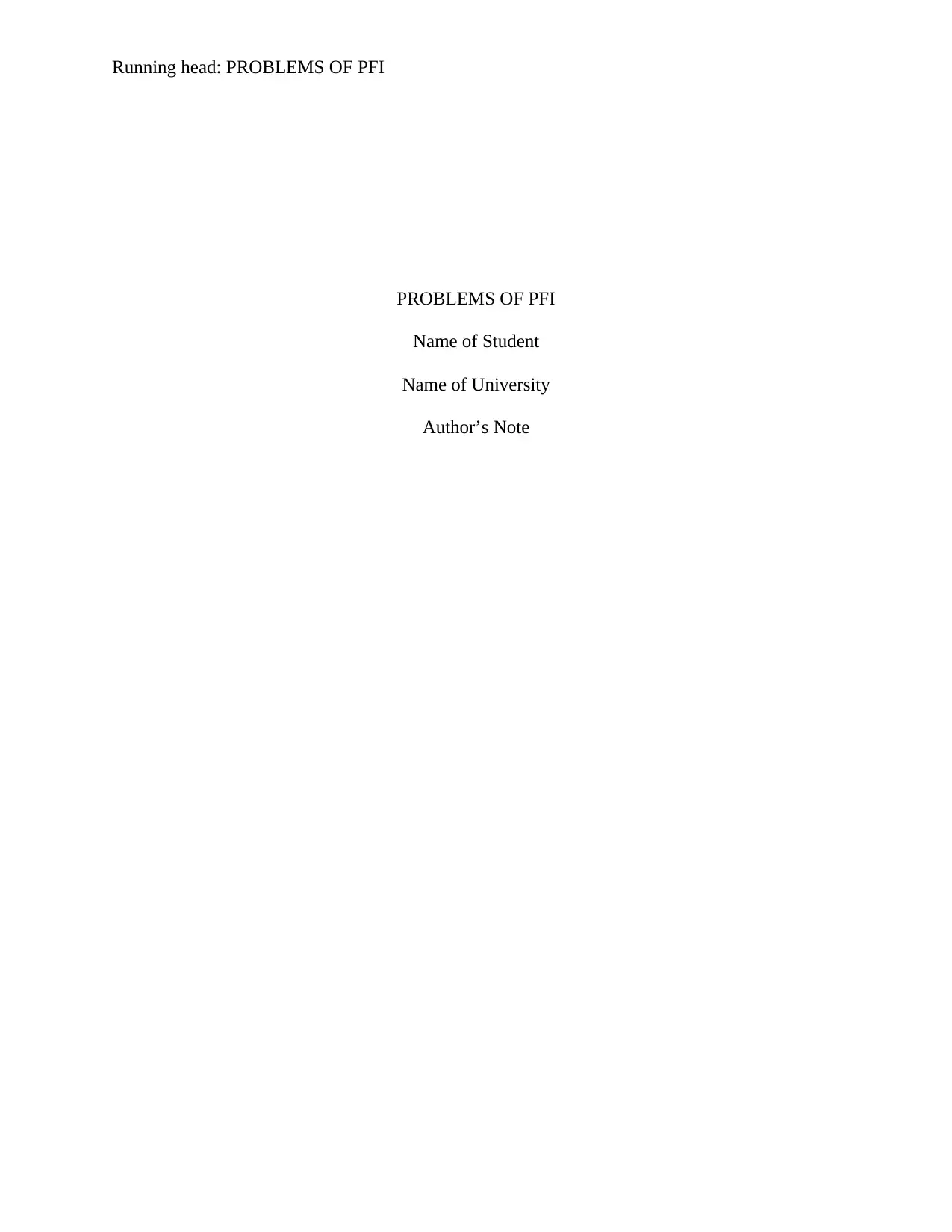
Running head: PROBLEMS OF PFI
PROBLEMS OF PFI
Name of Student
Name of University
Author’s Note
PROBLEMS OF PFI
Name of Student
Name of University
Author’s Note
Paraphrase This Document
Need a fresh take? Get an instant paraphrase of this document with our AI Paraphraser

1
PROBLEMS OF PFI
Table of Contents
PROBLEMS ASSOCIATED WITH PFI 1 AND PFI 2:.....................................................2
WHERE THE MONEY WENT?........................................................................................4
WHAT CAN BE DONE?....................................................................................................5
REFERENCES:...................................................................................................................6
PROBLEMS OF PFI
Table of Contents
PROBLEMS ASSOCIATED WITH PFI 1 AND PFI 2:.....................................................2
WHERE THE MONEY WENT?........................................................................................4
WHAT CAN BE DONE?....................................................................................................5
REFERENCES:...................................................................................................................6
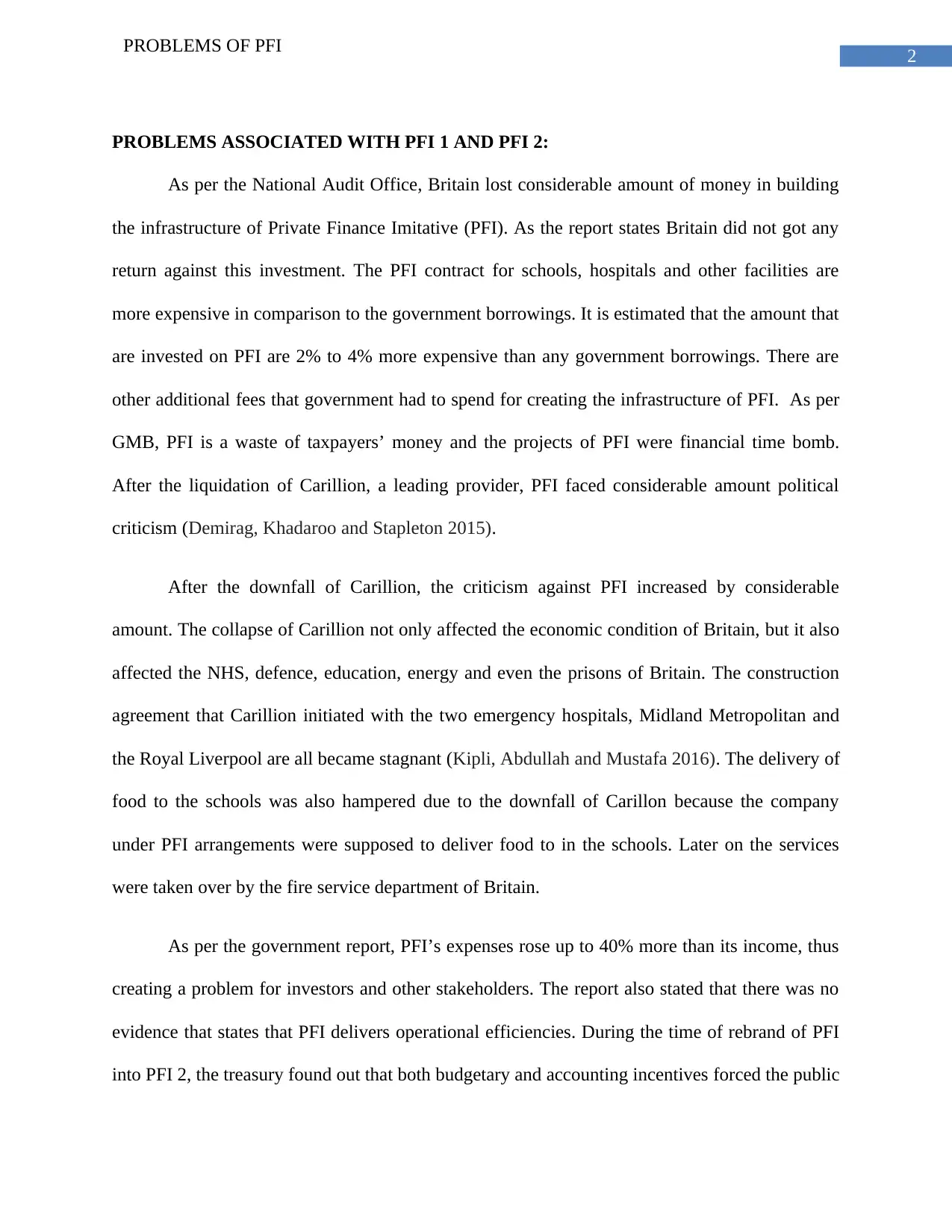
2
PROBLEMS OF PFI
PROBLEMS ASSOCIATED WITH PFI 1 AND PFI 2:
As per the National Audit Office, Britain lost considerable amount of money in building
the infrastructure of Private Finance Imitative (PFI). As the report states Britain did not got any
return against this investment. The PFI contract for schools, hospitals and other facilities are
more expensive in comparison to the government borrowings. It is estimated that the amount that
are invested on PFI are 2% to 4% more expensive than any government borrowings. There are
other additional fees that government had to spend for creating the infrastructure of PFI. As per
GMB, PFI is a waste of taxpayers’ money and the projects of PFI were financial time bomb.
After the liquidation of Carillion, a leading provider, PFI faced considerable amount political
criticism (Demirag, Khadaroo and Stapleton 2015).
After the downfall of Carillion, the criticism against PFI increased by considerable
amount. The collapse of Carillion not only affected the economic condition of Britain, but it also
affected the NHS, defence, education, energy and even the prisons of Britain. The construction
agreement that Carillion initiated with the two emergency hospitals, Midland Metropolitan and
the Royal Liverpool are all became stagnant (Kipli, Abdullah and Mustafa 2016). The delivery of
food to the schools was also hampered due to the downfall of Carillon because the company
under PFI arrangements were supposed to deliver food to in the schools. Later on the services
were taken over by the fire service department of Britain.
As per the government report, PFI’s expenses rose up to 40% more than its income, thus
creating a problem for investors and other stakeholders. The report also stated that there was no
evidence that states that PFI delivers operational efficiencies. During the time of rebrand of PFI
into PFI 2, the treasury found out that both budgetary and accounting incentives forced the public
PROBLEMS OF PFI
PROBLEMS ASSOCIATED WITH PFI 1 AND PFI 2:
As per the National Audit Office, Britain lost considerable amount of money in building
the infrastructure of Private Finance Imitative (PFI). As the report states Britain did not got any
return against this investment. The PFI contract for schools, hospitals and other facilities are
more expensive in comparison to the government borrowings. It is estimated that the amount that
are invested on PFI are 2% to 4% more expensive than any government borrowings. There are
other additional fees that government had to spend for creating the infrastructure of PFI. As per
GMB, PFI is a waste of taxpayers’ money and the projects of PFI were financial time bomb.
After the liquidation of Carillion, a leading provider, PFI faced considerable amount political
criticism (Demirag, Khadaroo and Stapleton 2015).
After the downfall of Carillion, the criticism against PFI increased by considerable
amount. The collapse of Carillion not only affected the economic condition of Britain, but it also
affected the NHS, defence, education, energy and even the prisons of Britain. The construction
agreement that Carillion initiated with the two emergency hospitals, Midland Metropolitan and
the Royal Liverpool are all became stagnant (Kipli, Abdullah and Mustafa 2016). The delivery of
food to the schools was also hampered due to the downfall of Carillon because the company
under PFI arrangements were supposed to deliver food to in the schools. Later on the services
were taken over by the fire service department of Britain.
As per the government report, PFI’s expenses rose up to 40% more than its income, thus
creating a problem for investors and other stakeholders. The report also stated that there was no
evidence that states that PFI delivers operational efficiencies. During the time of rebrand of PFI
into PFI 2, the treasury found out that both budgetary and accounting incentives forced the public
⊘ This is a preview!⊘
Do you want full access?
Subscribe today to unlock all pages.

Trusted by 1+ million students worldwide
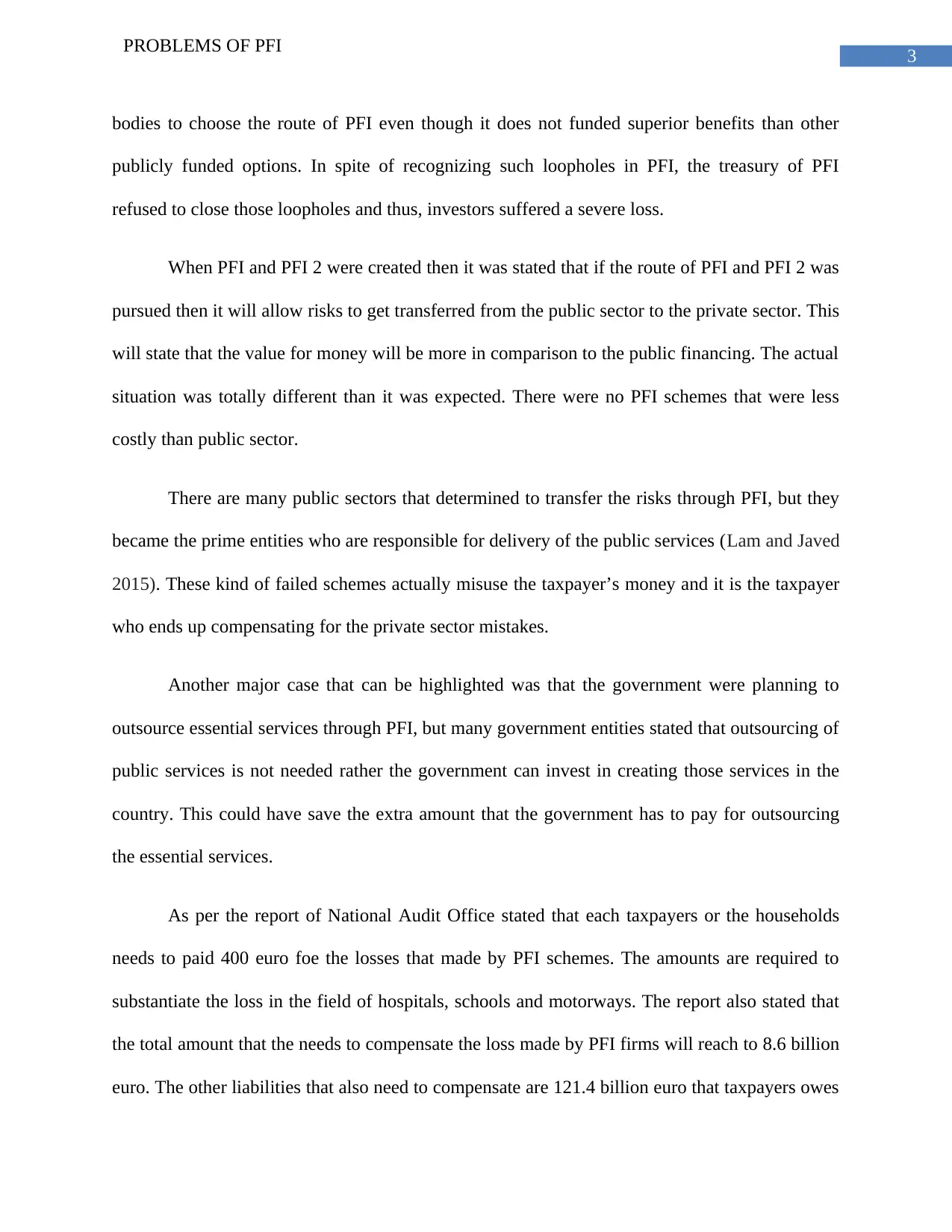
3
PROBLEMS OF PFI
bodies to choose the route of PFI even though it does not funded superior benefits than other
publicly funded options. In spite of recognizing such loopholes in PFI, the treasury of PFI
refused to close those loopholes and thus, investors suffered a severe loss.
When PFI and PFI 2 were created then it was stated that if the route of PFI and PFI 2 was
pursued then it will allow risks to get transferred from the public sector to the private sector. This
will state that the value for money will be more in comparison to the public financing. The actual
situation was totally different than it was expected. There were no PFI schemes that were less
costly than public sector.
There are many public sectors that determined to transfer the risks through PFI, but they
became the prime entities who are responsible for delivery of the public services (Lam and Javed
2015). These kind of failed schemes actually misuse the taxpayer’s money and it is the taxpayer
who ends up compensating for the private sector mistakes.
Another major case that can be highlighted was that the government were planning to
outsource essential services through PFI, but many government entities stated that outsourcing of
public services is not needed rather the government can invest in creating those services in the
country. This could have save the extra amount that the government has to pay for outsourcing
the essential services.
As per the report of National Audit Office stated that each taxpayers or the households
needs to paid 400 euro foe the losses that made by PFI schemes. The amounts are required to
substantiate the loss in the field of hospitals, schools and motorways. The report also stated that
the total amount that the needs to compensate the loss made by PFI firms will reach to 8.6 billion
euro. The other liabilities that also need to compensate are 121.4 billion euro that taxpayers owes
PROBLEMS OF PFI
bodies to choose the route of PFI even though it does not funded superior benefits than other
publicly funded options. In spite of recognizing such loopholes in PFI, the treasury of PFI
refused to close those loopholes and thus, investors suffered a severe loss.
When PFI and PFI 2 were created then it was stated that if the route of PFI and PFI 2 was
pursued then it will allow risks to get transferred from the public sector to the private sector. This
will state that the value for money will be more in comparison to the public financing. The actual
situation was totally different than it was expected. There were no PFI schemes that were less
costly than public sector.
There are many public sectors that determined to transfer the risks through PFI, but they
became the prime entities who are responsible for delivery of the public services (Lam and Javed
2015). These kind of failed schemes actually misuse the taxpayer’s money and it is the taxpayer
who ends up compensating for the private sector mistakes.
Another major case that can be highlighted was that the government were planning to
outsource essential services through PFI, but many government entities stated that outsourcing of
public services is not needed rather the government can invest in creating those services in the
country. This could have save the extra amount that the government has to pay for outsourcing
the essential services.
As per the report of National Audit Office stated that each taxpayers or the households
needs to paid 400 euro foe the losses that made by PFI schemes. The amounts are required to
substantiate the loss in the field of hospitals, schools and motorways. The report also stated that
the total amount that the needs to compensate the loss made by PFI firms will reach to 8.6 billion
euro. The other liabilities that also need to compensate are 121.4 billion euro that taxpayers owes
Paraphrase This Document
Need a fresh take? Get an instant paraphrase of this document with our AI Paraphraser
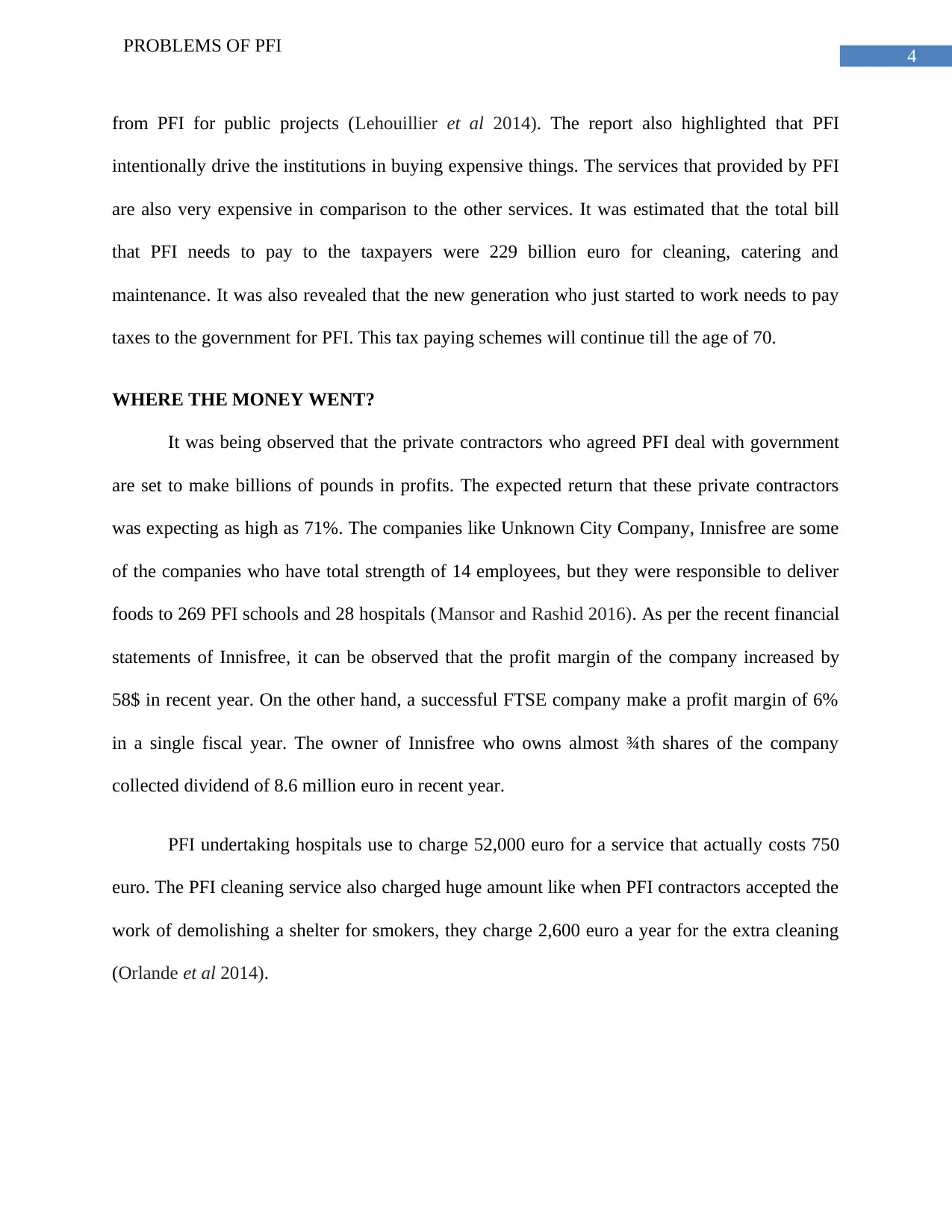
4
PROBLEMS OF PFI
from PFI for public projects (Lehouillier et al 2014). The report also highlighted that PFI
intentionally drive the institutions in buying expensive things. The services that provided by PFI
are also very expensive in comparison to the other services. It was estimated that the total bill
that PFI needs to pay to the taxpayers were 229 billion euro for cleaning, catering and
maintenance. It was also revealed that the new generation who just started to work needs to pay
taxes to the government for PFI. This tax paying schemes will continue till the age of 70.
WHERE THE MONEY WENT?
It was being observed that the private contractors who agreed PFI deal with government
are set to make billions of pounds in profits. The expected return that these private contractors
was expecting as high as 71%. The companies like Unknown City Company, Innisfree are some
of the companies who have total strength of 14 employees, but they were responsible to deliver
foods to 269 PFI schools and 28 hospitals (Mansor and Rashid 2016). As per the recent financial
statements of Innisfree, it can be observed that the profit margin of the company increased by
58$ in recent year. On the other hand, a successful FTSE company make a profit margin of 6%
in a single fiscal year. The owner of Innisfree who owns almost ¾th shares of the company
collected dividend of 8.6 million euro in recent year.
PFI undertaking hospitals use to charge 52,000 euro for a service that actually costs 750
euro. The PFI cleaning service also charged huge amount like when PFI contractors accepted the
work of demolishing a shelter for smokers, they charge 2,600 euro a year for the extra cleaning
(Orlande et al 2014).
PROBLEMS OF PFI
from PFI for public projects (Lehouillier et al 2014). The report also highlighted that PFI
intentionally drive the institutions in buying expensive things. The services that provided by PFI
are also very expensive in comparison to the other services. It was estimated that the total bill
that PFI needs to pay to the taxpayers were 229 billion euro for cleaning, catering and
maintenance. It was also revealed that the new generation who just started to work needs to pay
taxes to the government for PFI. This tax paying schemes will continue till the age of 70.
WHERE THE MONEY WENT?
It was being observed that the private contractors who agreed PFI deal with government
are set to make billions of pounds in profits. The expected return that these private contractors
was expecting as high as 71%. The companies like Unknown City Company, Innisfree are some
of the companies who have total strength of 14 employees, but they were responsible to deliver
foods to 269 PFI schools and 28 hospitals (Mansor and Rashid 2016). As per the recent financial
statements of Innisfree, it can be observed that the profit margin of the company increased by
58$ in recent year. On the other hand, a successful FTSE company make a profit margin of 6%
in a single fiscal year. The owner of Innisfree who owns almost ¾th shares of the company
collected dividend of 8.6 million euro in recent year.
PFI undertaking hospitals use to charge 52,000 euro for a service that actually costs 750
euro. The PFI cleaning service also charged huge amount like when PFI contractors accepted the
work of demolishing a shelter for smokers, they charge 2,600 euro a year for the extra cleaning
(Orlande et al 2014).
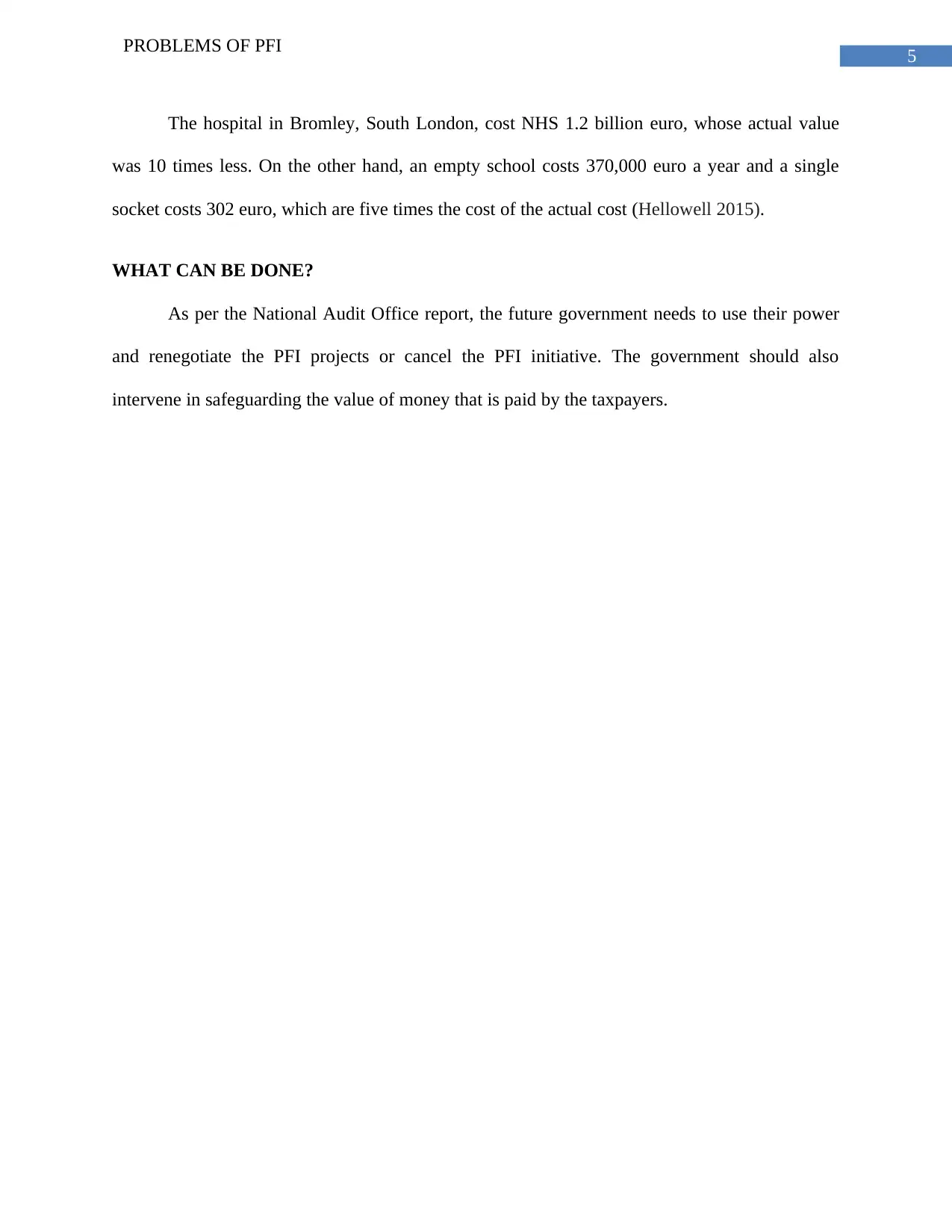
5
PROBLEMS OF PFI
The hospital in Bromley, South London, cost NHS 1.2 billion euro, whose actual value
was 10 times less. On the other hand, an empty school costs 370,000 euro a year and a single
socket costs 302 euro, which are five times the cost of the actual cost (Hellowell 2015).
WHAT CAN BE DONE?
As per the National Audit Office report, the future government needs to use their power
and renegotiate the PFI projects or cancel the PFI initiative. The government should also
intervene in safeguarding the value of money that is paid by the taxpayers.
PROBLEMS OF PFI
The hospital in Bromley, South London, cost NHS 1.2 billion euro, whose actual value
was 10 times less. On the other hand, an empty school costs 370,000 euro a year and a single
socket costs 302 euro, which are five times the cost of the actual cost (Hellowell 2015).
WHAT CAN BE DONE?
As per the National Audit Office report, the future government needs to use their power
and renegotiate the PFI projects or cancel the PFI initiative. The government should also
intervene in safeguarding the value of money that is paid by the taxpayers.
⊘ This is a preview!⊘
Do you want full access?
Subscribe today to unlock all pages.

Trusted by 1+ million students worldwide
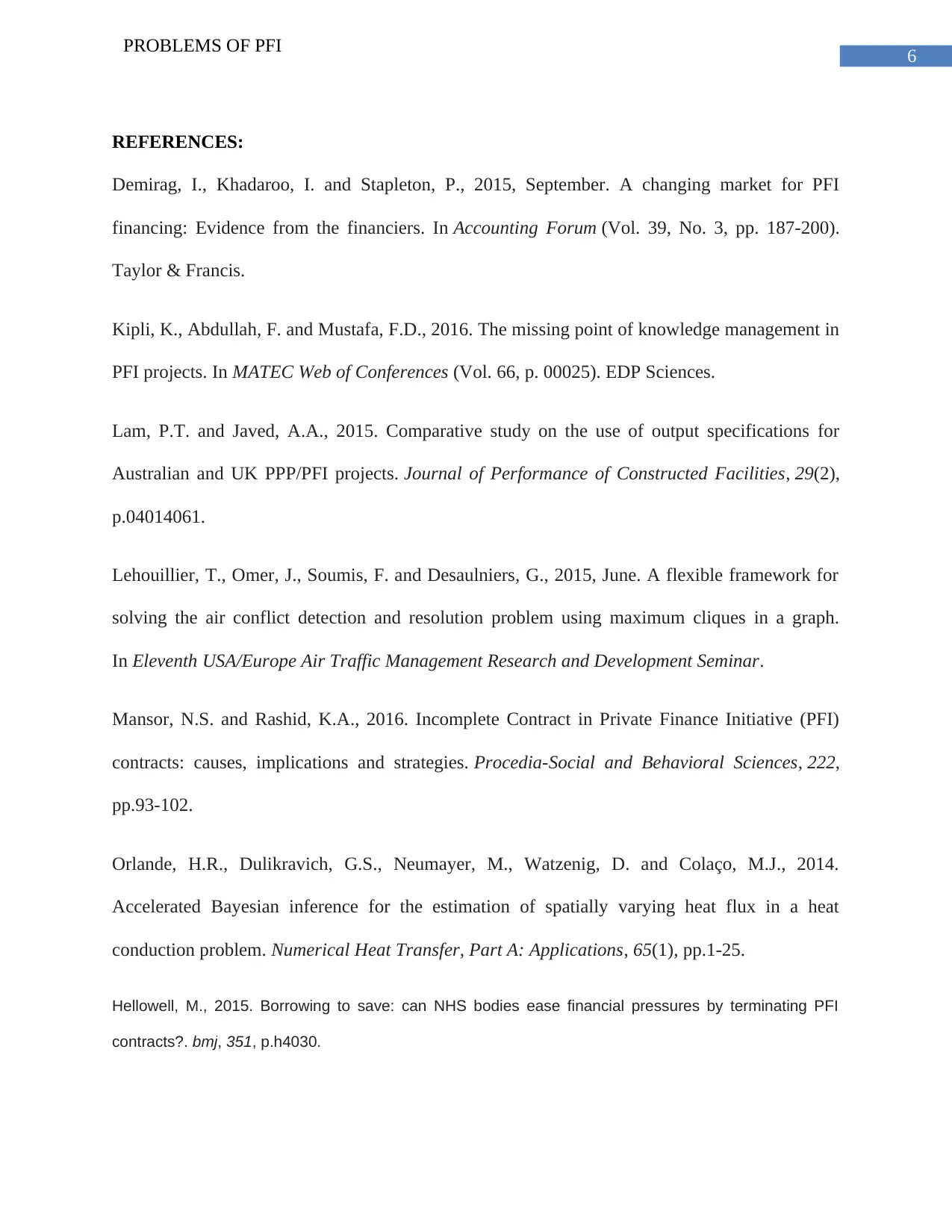
6
PROBLEMS OF PFI
REFERENCES:
Demirag, I., Khadaroo, I. and Stapleton, P., 2015, September. A changing market for PFI
financing: Evidence from the financiers. In Accounting Forum (Vol. 39, No. 3, pp. 187-200).
Taylor & Francis.
Kipli, K., Abdullah, F. and Mustafa, F.D., 2016. The missing point of knowledge management in
PFI projects. In MATEC Web of Conferences (Vol. 66, p. 00025). EDP Sciences.
Lam, P.T. and Javed, A.A., 2015. Comparative study on the use of output specifications for
Australian and UK PPP/PFI projects. Journal of Performance of Constructed Facilities, 29(2),
p.04014061.
Lehouillier, T., Omer, J., Soumis, F. and Desaulniers, G., 2015, June. A flexible framework for
solving the air conflict detection and resolution problem using maximum cliques in a graph.
In Eleventh USA/Europe Air Traffic Management Research and Development Seminar.
Mansor, N.S. and Rashid, K.A., 2016. Incomplete Contract in Private Finance Initiative (PFI)
contracts: causes, implications and strategies. Procedia-Social and Behavioral Sciences, 222,
pp.93-102.
Orlande, H.R., Dulikravich, G.S., Neumayer, M., Watzenig, D. and Colaço, M.J., 2014.
Accelerated Bayesian inference for the estimation of spatially varying heat flux in a heat
conduction problem. Numerical Heat Transfer, Part A: Applications, 65(1), pp.1-25.
Hellowell, M., 2015. Borrowing to save: can NHS bodies ease financial pressures by terminating PFI
contracts?. bmj, 351, p.h4030.
PROBLEMS OF PFI
REFERENCES:
Demirag, I., Khadaroo, I. and Stapleton, P., 2015, September. A changing market for PFI
financing: Evidence from the financiers. In Accounting Forum (Vol. 39, No. 3, pp. 187-200).
Taylor & Francis.
Kipli, K., Abdullah, F. and Mustafa, F.D., 2016. The missing point of knowledge management in
PFI projects. In MATEC Web of Conferences (Vol. 66, p. 00025). EDP Sciences.
Lam, P.T. and Javed, A.A., 2015. Comparative study on the use of output specifications for
Australian and UK PPP/PFI projects. Journal of Performance of Constructed Facilities, 29(2),
p.04014061.
Lehouillier, T., Omer, J., Soumis, F. and Desaulniers, G., 2015, June. A flexible framework for
solving the air conflict detection and resolution problem using maximum cliques in a graph.
In Eleventh USA/Europe Air Traffic Management Research and Development Seminar.
Mansor, N.S. and Rashid, K.A., 2016. Incomplete Contract in Private Finance Initiative (PFI)
contracts: causes, implications and strategies. Procedia-Social and Behavioral Sciences, 222,
pp.93-102.
Orlande, H.R., Dulikravich, G.S., Neumayer, M., Watzenig, D. and Colaço, M.J., 2014.
Accelerated Bayesian inference for the estimation of spatially varying heat flux in a heat
conduction problem. Numerical Heat Transfer, Part A: Applications, 65(1), pp.1-25.
Hellowell, M., 2015. Borrowing to save: can NHS bodies ease financial pressures by terminating PFI
contracts?. bmj, 351, p.h4030.
Paraphrase This Document
Need a fresh take? Get an instant paraphrase of this document with our AI Paraphraser

7
PROBLEMS OF PFI
PROBLEMS OF PFI
1 out of 8
Your All-in-One AI-Powered Toolkit for Academic Success.
+13062052269
info@desklib.com
Available 24*7 on WhatsApp / Email
![[object Object]](/_next/static/media/star-bottom.7253800d.svg)
Unlock your academic potential
Copyright © 2020–2025 A2Z Services. All Rights Reserved. Developed and managed by ZUCOL.
